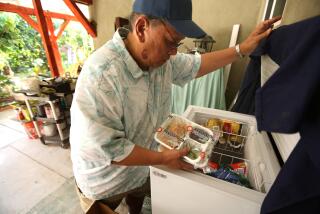Aid Cutoff Leaves Marks of a Double-Edged Sword : Welfare: Loss of benefits spurs some in Iowa group to find work. Others careen among damaging alternatives.
- Share via
DAVENPORT, Iowa — For nearly 20 years, as she has been raising five children, there has been one constant in Julie Pearl’s life: a welfare check.
No job lasted more than a year. Men came and went. But welfare was always there, until last fall. That is when Pearl became one of the first mothers in the country to lose her benefits as part of the nationwide movement to crack down on those who have been making welfare a way of life rather than a respite.
Now, unwillingly, Pearl and a small group of others like her have begun to supply an answer to the most sensitive and hotly disputed question of all in the debate over how to remake the nation’s welfare system: What happens to people when they are cut off?
Or, more urgently, what happens to their young children?
Some of the reform plans now being weighed by Congress, and being tested in a few states, would completely drop recipients who do not take steps to end their dependency or who break tough new work rules.
Will the jolt of the cutoff spur recipients out of dependency and into the work world to support their families? Or, as many social activists warn, will many slide into utter destitution and homelessness, taking their children with them?
The uncertainty of the answer is a reason why those on both sides of the issue are treading gingerly now as they try to devise the actual workings of a new system and to define what the “out” in such slogans as “two years and out” will really mean.
The experience of Pearl and others here in Iowa, the first state to actually cut off errant recipients’ checks as part of a federally authorized experiment, shows why.
“When they stopped coming, it was like a ton of bricks dropped on me,” says Pearl, 35, who has been on the dole since she was a 15-year-old with a toddler. “It made me think of selling drugs, or prostitution, or doing whatever it would take to survive.”
Finally, she left her 11-year-old daughter and 16-year-old son with relatives and moved into the Salvation Army shelter in Davenport with her twin 5-year-old boys.
She said she doesn’t know how long that will last or what comes next. A training course in truck-driving she is taking might be a way out, or dancing in a nightclub, or just “doing whatever I have to do to get fast, easy money.”
Fortunately, Pearl and her children are not starving, and she is thinking more seriously about work than she did before. Those reassuring results appear to hold for a sample of the 760 families expelled from the Iowa system in the last four months. This first-dropped group has coped in a variety of ways, including getting help from other agencies and private organizations, moving to neighboring states with more lenient welfare rules, or even getting decent jobs.
But the experiment has also shown a troubling pattern of young families careening among a range of damaging alternatives, including crime. Other families have simply turned to local agencies that have fewer resources but cannot easily turn people away because the consequences would quickly appear on their own streets. Rather than escaping their dependence on public support, the dropped mothers are merely changing the public support on which they depend.
Already in Iowa, community agencies and charities are starting to wonder what they will do if every few months brings hundreds more cutoff families in search of food and beds.
“All of our shelters are already full, and the waiting lists are full. I don’t know how we’re going to handle it,” said Kate Ridge, head of a coalition of homeless shelters and transitional-housing organizations in Davenport.
She said her coalition could not expand enough from the 500 beds it has to meet the expected demand in the Quad Cities area, which includes Davenport and Bettendorf on the Iowa side of the Mississippi River and Moline and Rock Island in Illinois.
“Local, state and national officials have to take a hard look at what reality is,” she said. “. . . I have an underlying feeling it’s going to be reminiscent of the Depression.”
Barbara Dean, who runs the Neighborhood Place subsidized housing program, said that when all the local help is exhausted, “they’ll find other things to take its place. We don’t know what it will be. I know for some it could be stealing.”
Some local and federal emergency assistance money is available for peak demand, said Lloyd Ogle of the Iowa Coalition for the Homeless in Des Moines, but much of the total for 1995 had been used up by February.
The tougher Iowa system is a product of the broad sentiment now gripping much of the nation. Too many of the state’s 40,000 families receiving Aid for Families With Dependent Children were considered long-term dependents, caught in a destructive cycle of joblessness, lack of education and babies born out of wedlock. The cycle had to be broken.
A year ago, with federal approval, the state imposed a plan that required recipients to sign a contract detailing steps they would take to become self-supporting, such as enrolling in training, getting their high school equivalency degree or starting a job. Violating the terms initially would bring a reduction in benefits. Then, for those not making the required progress within six months, checks could be cut off entirely. A second chance might be allowed, but not until after six months.
For some recipients, the threat clearly had the desired effect.
Evelyn Mayze, a 23-year-old high school graduate, had been on welfare since her son was born four years ago, but the new penalty got her thinking about the future.
“I’ve been wanting to get a job but was afraid to,” said Mayze, who just landed a part-time position selling shoes at a department store. “The fact that they would have cut it completely off--that made me get a job.”
Her caseworker said that if all goes well, Mayze should be able to graduate to a full-time job before long and be weaned off welfare completely.
In addition to those getting jobs, the state can also claim a more qualified form of success: those who may still be dependent but not in Iowa.
“I’ve got a handful of clients who have or are moving to Illinois,” said Scott Stablein, a welfare caseworker in Davenport, where moving to Illinois means driving across a bridge.
State officials say they do not have records on how many recipients have moved into the job market or to greener pastures elsewhere, but they are confident the overall effect of the change has been good.
“I would say that the program is successful,” said Gloria Conrad, director of the state office that developed the plan.
But officials acknowledge they have little idea what became of the families who were cut off.
The first month after recipients are cut off, the state sends a nurse to see whether family members should be referred to other agencies. A few have been directed to substance-abuse or mental-health services.
But in most cases, said nurse Lori Steger, “when I go to visit someone, the apartment is empty or they’re being evicted.”
For some, such as Pearl, the next step toward the streets is harrowing.
At first she shoplifted from grocery stores to feed her children, but that didn’t take care of a place to stay. Drug dealing was a possibility, but she said she was afraid she would fall back into a drug habit that she had fought hard to defeat.
So finally she settled on breaking up her family, at least for now, until she could come up with something better.
After Elizabeth Parker, 25, lost her welfare checks last October, she tried to hold on to her household but gave up after the heat was cut off. She wound up moving in with her mother and, later, her boyfriend. Her three children are not going hungry but must live in cramped conditions.
She has applied for assistance from the Federal Emergency Management Agency and hopes they will give her enough to prevent foreclosure on her house, which, at $263 a month, is cheaper than an apartment. In the meantime, she is receiving help from another local agency.
Darlene McCauley, 26, said she and her two children faced the prospect of becoming homeless when her checks stopped. But a charity agreed to continue subsidizing her apartment, and she persuaded the state after three months to resume her payments. “If I had not lived here where they’re more understanding, I would have been out on the streets,” McCauley said, her eyes brimming with tears.
The jolt of lost benefits was particularly abrupt for a few who were cut off by mistake--as was the case with Maria Duran, who, with her four children frantic and the bank moving to foreclose, found her husband sobbing one night on the couch, apparently contemplating suicide.
The worst was averted when local charities pitched in money to tide them over until the state discovered its computer error and resumed the checks.
The experiences illustrate the bleak options some recipients confront and the likelihood they will still be reliant on public support even if not welfare.
Sandra Danziger, a University of Michigan professor of social work, said research she has conducted on long-term public support recipients in Michigan indicated few of those who lose their benefits are able to become self-sufficient.
Two years after Michigan cut off some recipients from cash assistance in 1991, only a fifth were employed and only one in 20 was earning as much as welfare paid, she said.
“People moved over to different sources of support,” producing little net social savings, Danziger said in an interview.
Also, most long-term AFDC recipients tend to share characteristics that limit their opportunities for earning a living. For example, researcher Donna Pavetti of the Urban Institute found that three-fourths scored in the lowest quarter of the Armed Forces Qualifying Test, a basic aptitude measure.
But those watching the Iowa method say they are less concerned about the buffeting the adults endure, deserved or otherwise, than the effect on the children. Intense stress on a family sometimes can increase abuse or neglect, they said.
Those crafting welfare reform plans in Washington and the states say they are balancing these concerns as they try to devise a system that cracks down on the unmotivated but not the helpless.
The GOP plan making its way through the House would require states to limit cash welfare to five years for each family over a lifetime. States, however, would be allowed to enforce much stricter time limits. Virginia, for instance, just passed a law to require welfare recipients to work after 90 days and to limit cash benefits to two years. The law needs federal approval unless the GOP welfare plan passes first.
But some states are trying to make a cutoff as unlikely as possible by virtually guaranteeing recipients some kind of work if they cannot find it themselves.
Rep. E. Clay Shaw Jr. (R-Fla.), chairman of the subcommittee that drafted the House GOP welfare proposal, said some distress may be unavoidable if many young people are to be saved from the equally destructive specter of perpetual dependency.
“We can’t just lay the present generation to waste; they are going to be the model for the next generation,” Shaw said. “But it’s going to be tough for them to get over the gulf.”
More to Read
Sign up for Essential California
The most important California stories and recommendations in your inbox every morning.
You may occasionally receive promotional content from the Los Angeles Times.










